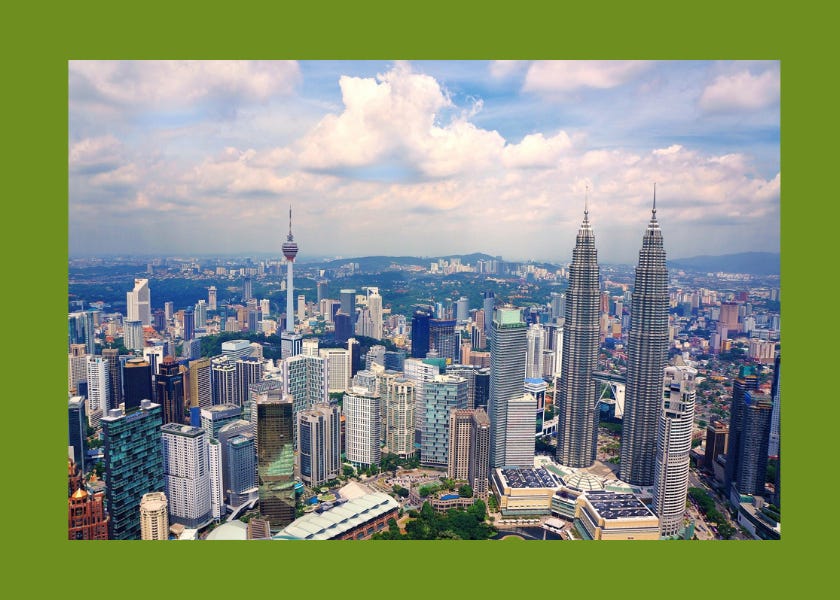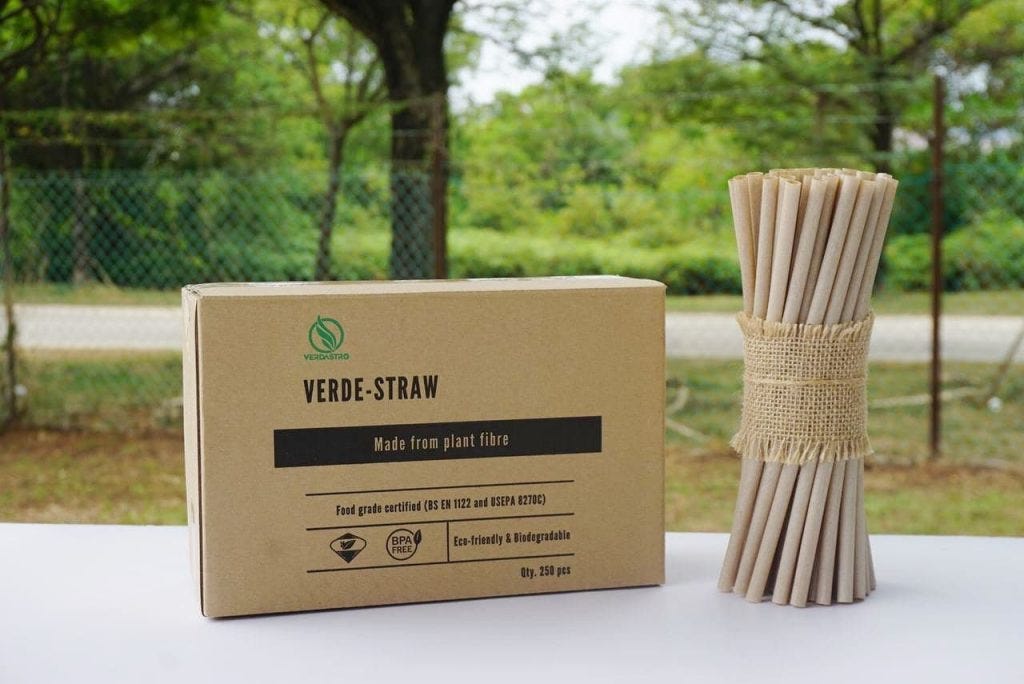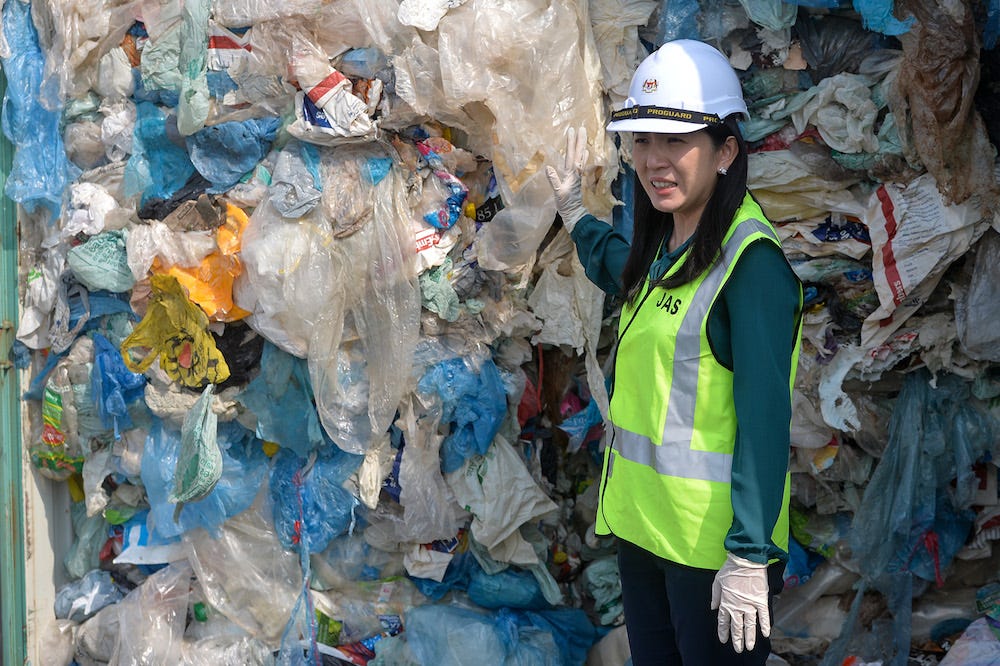Deep dive: Malaysia's circular economy journey
From palm oil paradoxes to dump-truck dramas, Malaysia’s circular economy story proves that size ≠ impact.

Hi! Mutiara here from SEArcularity. 👋🏼
After deep diving into Singapore's landscape in circular economy, we're moving onto the neighbour right next door.
The starting point of where I first learnt about the struggles that Southeast Asian nations have in restructuring their waste management system, and my second home: Malaysia. ❤️
Malaysia is creating its own path towards circularity—one that considers its recurring environmental issues whilst harnessing its abundant natural resources as potential drivers towards sustainable innovation.
💡 Interesting take from Malaysia: The nation has pledged net-zero emissions by 2050—an ambitious target considering fossil fuels currently contribute 20% to its GDP and a more aggressive timeline than regional neighbours Thailand (2065) and Indonesia (2060).
Building on this commitment, Malaysia is now embracing circular economy principles as a pathway to sustainable development that addresses both environmental challenges and economic growth.
Malaysia's current waste challenge
Malaysia's waste management situation has reached critical mass:
♨️ Landfill Emergency: With 18,000 tons of waste entering landfills daily, Malaysia's 146 landfills could reach capacity by 2050 without intervention
🏆 Consumer Waste Olympics: Malaysians generate 1.17 kg of waste per person daily
⛰ Diaper Mountain: Disposable diapers comprise a whopping 12.1% of household waste (equivalent to 4.7 million diapers buried daily)
🥗 Food Waste Flood: 44.5% of household trash is edible surplus
🧻 Plastic and paper waste make up a big amount of household waste, at 13.2% and 8.5%, respectively
The crisis is further worsened by illegal dumping networks that are so pervasive that authorities seized 135 vehicles used for unlawful waste disposal in Kuala Selangor alone between 2020-2025.
Social and infrastructure challenges
Despite ambitious policies, significant obstacles remain:
Recycling Gap: Malaysia's 31.67% recycling rate (2021) falls short of its 40% target, hampered by inconsistent collection infrastructure
Diaper Disposal: Despite comprising 12% of waste volume, Malaysia lacks a national diaper recycling program
Waste-to-Energy (WtE) Resistance: Communities near planned waste-to-energy facilities have mounted opposition, echoing early skepticism faced by similar projects elsewhere
Malaysia's circular economy blueprint (2025-2035)
Recognising the urgency, Malaysia has developed a blueprint that targets the waste crisis from multiple angles:
🔁 1. Extended Producer Responsibility (EPR) mandate
Malaysia is implementing mandatory EPR across key sectors with substantial enforcement mechanisms:
Phased Implementation: Electronics (2026), plastics (2027), packaging (2028)
Financial Responsibility: Manufacturers must fund collection/recycling infrastructure for their products
EPR with Teeth: Companies face fines for non-compliance; the amount is undisclosed
Expected Impact: Projected to reduce packaging waste by 15% by 2030
Read also 👉 Deep dive on Singapore's circular economy strategy
♻️ 2. Zero waste to landfill certification
This corporate-focused initiative creates incentives for waste diversion:
Qualification Standard: Companies must divert 95% of waste from landfills through recycling/upcycling
Energy Recovery: Permitted only for demonstrably non-recyclable materials
Dual Incentives: Certified companies receive tax breaks while non-compliant firms become ineligible for government contracts
💸 3. Pay-As-You-Throw (PAYT) scheme
Malaysia is shifting to a usage-based waste disposal model:
Commercial Sector: RM0.50/kg landfill disposal fee
Construction Industry: RM1.20/kg for mixed construction debris
Manufacturing: Tiered rates based on waste intensity and type
Proven Results: A pilot program in Selangor reduced commercial waste by 22% in just six months
⚡️ 4. Waste-to-Energy (WtE) expansion
Malaysia is rapidly scaling its WtE capacity and the blueprint aims to address this:
2035 Target: 18 WtE plants processing 8,000+ tons daily
Landfill Impact: Expected to reduce landfill dependence by 40%
🏭 5. Manufacturing transformation
The Ministry of International Trade and Industry's Circular Economy Policy Framework (2024) targets industrial change:
Petrochemical Transition: The sector, responsible for 20% of national emissions, must adopt circular feedstock by 2030
Investment Strategy: $1.2 billion allocated for remanufacturing hubs in Penang and Iskandar
APEC Alignment: Coordinated with the 2020 APEC circular economy roadmap, emphasising industrial symbiosis initiatives like converting palm oil waste into bio-plastics
Malaysia possesses abundant biological resources that could fuel circular innovation.
The palm oil industry, often criticised for its environmental impact, actually has a hidden circular economy opportunity.
"Our oil palm waste could become tomorrow's green gold."
—MITI Minister Tengku Zafrul
A Malaysian startup, Verdastro, is already on its way to transforming its potential, converting palm oil mill effluent into bioplastics that can be used as straws.

Malaysia's political leadership and global positioning
Malaysia's circular economy transition has benefited from political champions.
Former Environment Minister Yeoh Bee Yin became an environmental icon in 2020 when she rejected 3,000+ containers of illegal waste imports.
"We won't be the world's trash can."
—Former Minister Yeoh Bee Yin
I was still living in Malaysia when this happened.
It was incredible to witness YB Yeoh Bee Yin personally go to the site, conduct inspections, and hold a declaration to refuse the illegal waste imports—all while being 7-months pregnant. Talk about having a woman in politics. Such a powerful move!
Adding up to this, Malaysia still puts a strong stance on their refusal of illegal waste as the Department of Environment cracked down illegal e-waste processing operations nationwide, with seizures amounting to RM3.8 billion as of February 2025.
Read also 👉 Southeast Asia's electronic dumping ground
The road ahead…
As the 2025 ASEAN Chair, Malaysia is advancing regional circular economy initiatives:
Standardising EPR frameworks across Southeast Asia
Facilitating waste-to-energy technology sharing between member states
Coordinating harmonised policies on single-use plastics
Stay tuned for more deep dives into other Southeast Asian countries in the following weeks!
—SEArcularity
P.S. Are you a business, organisation, or individual with circular ideas you’d like to share? Comment below or email hi@searcularity.com for a potential feature 📩




